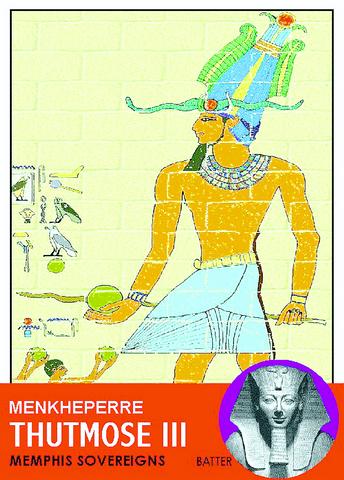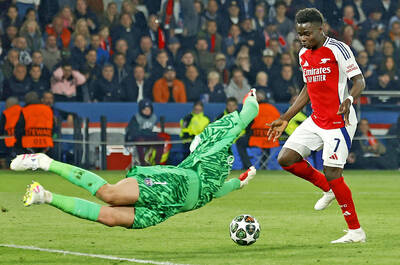No disrespect meant to Abner Doubleday or Alexander Cartwright or anybody else who might claim responsibility for the game we call baseball, but Thutmose III had them beat by three millennia or so. Thutmose ruled Egypt during the 15th century BC, and is the first known pharaoh to have depicted himself in a ritual known as "seker-hemat," which Peter Piccione has loosely translated as "batting the ball."
"The word they use is `sequer,' which literally means `to strike' or `to hit,"' said Piccione, 51, an Egyptologist and professor of comparative ancient history at the College of Charleston in South Carolina, "but in the context, he's there with the bat. I translated it as `batting the ball."'

PHOTO: NYT
The context he's referring to is a wall relief at the shrine of Hathor, the goddess of love and joy, in Hatshepsut's temple at Deir-el-Bahari, where Thutmose is seen holding a softball-size ball in one hand and a long stick, wavy at the end, in the other. The hieroglyphic over the scene reads: "Batting the ball for Hathor, who is foremost in Thebes." The date is 1475 BC.
Piccione makes a specialty of Egyptian religion.
He's particularly interested in the sports and games that the ancient Egyptians included in festivals honoring certain deities, a pursuit that led him to muse on the relationship between ancient Egyptian "baseball" and American baseball.
His findings are included in a popular lecture -- called "Pharaoh at the Bat" -- that he recently delivered in Charleston and has been honing since delivering a paper on the subject at the National Baseball Hall of Fame in 1995. In it, he describes a relationship similar to the one between, say, pterodactyls and cardinals, orioles or blue jays.
"There's no direct connection, and Egyptians don't play anything like this at all today," Piccione said. "But the Egyptian game did function as a precursor. There are only a few bat and ball games that have ever been around."
Actually, Piccione said, Egyptians probably batted the ball around, even if it was just for infield practice or a game of pepper, for nearly 1,000 years before Thutmose III. There are references to the activity in inscriptions inside the pyramids dating to 2400 BC.
Evidently the Egyptians weren't merely sluggers. They had a healthy respect as well for defense; the picture of Thutmose also shows two priests, small figures, in the act of catching a ball.
"They have their arms raised up and balls in their hands like you would catch a softball," Piccione said. "The inscription says, `Catching it for him by the servants of the gods."'
It isn't known precisely how the game was played, or if the umpires wore chest protectors. "To be honest, we don't know if they did any running," Piccione said, "but I suspect they did, because kings did a lot of running rituals."
Actually, the connections Piccione's lecture makes between then and there and here and now are more broadly cultural in nature.
"It started in Egypt as purely a boys' game," said Piccione. "And it was probably played in a festival, so the actual ball-playing took on some kind of religious meaning because it was played in a religious context."
When the king came out and played, therefore, the excitement and fun of the game and its religious meaning were consolidated, he said.
"Baseball functions the same way," he said. "Over time it has accumulated meaning. It's an interesting parallel development."
He cites the idea that every spring baseball starts up again, and as such it has become a ritual of the season. He cites the mythology that grows up around the players and lasts for generations, the near godliness of figures like Babe Ruth, the identification of the game with our country.
Happily, both in his lecture and in the interview, Piccione stopped before his musings got too ponderous. He finished both with a reading from his own version of Ernest Lawrence Thayer's Casey at the Bat, which ends, alas, just as badly for the home team: "O' somewhere in the Aten's circuit, the sun is shining bright, Nubian drums play somewhere and Hittite hearts are light/In Babylon men are laughing, in Nineveh children shout, But there is no joy in Mud-brickville, Great Pharaoh has struck out."

Freddie Freeman homered and drove in four runs, Shohei Ohtani also went deep and Roki Sasaki earned his first major league win as the Los Angeles Dodgers beat the Atlanta Braves 10-3 on Saturday night for their seventh straight victory. The Dodgers have won the first two games of the series to improve to 5-0 against Atlanta this year. Los Angeles’ three-game sweep at home early in the season left the Braves 0-7. Sasaki allowed three runs and six hits over five innings. The 23-year-old right-hander gave up a home run to Ozzie Albies, but received plenty of offensive support in his

INTER AWAIT: Superb saves by PSG ’keeper Gianluigi Donnarumma inspired the victory, as Arsenal were punished for misses, including one by Bukayo Saka Arsenal on Wednesday fell short on the big stage again as their painful UEFA Champions League semi-final exit against Paris Saint-Germain left Mikel Arteta to rue his club’s failure to provide him with enough attacking options. Arteta’s side were unable to reach the Champions League final for the first time in 19 years as PSG clinched a tense 2-1 win at Parc des Princes. Trailing 1-0 from last week’s first leg in London, the Gunners made a blistering start to the second leg, but could not convert their chances as Gianluigi Donnarumma’s superb saves inspired PSG’s 3-1 aggregate victory. Arsenal were punished for

Bayern Munich on Sunday were crowned German champions for the 34th time, giving striker Harry Kane his first major trophy, after second-placed Bayer 04 Leverkusen drew 2-2 at SC Freiburg. Bayern’s 3-3 draw at RB Leipzig on Saturday, when the Bavarians came from two goals down to take the lead before conceding a stoppage-time equalizer, meant defending Bundesliga champions Leverkusen needed to win at Freiburg to delay the title party. Leverkusen were two goals down before scoring twice in the final 10 minutes, but Xabi Alonso’s side could not find a third, as Bayern reclaimed the title at the first attempt after

THRILLER: Raphinha gave Barca a 3-2 lead with two minutes remaining of regular time, but Francesco Acerbi equalized the game in the second minute of added time Davide Frattesi on Tuesday fired Inter into the UEFA Champions League final with an extra-time winner that gave the Italians a stunning 4-3 triumph over Barcelona, 7-6 on aggregate. Italy midfielder Frattesi won a tie for the ages under a downpour in Milan when he lashed home in the 99th minute, sending a packed and rocking San Siro wild with joy. Simone Inzaghi’s team will face either Arsenal or Paris Saint-Germain at the end of this month in Munich, Germany, where they would feel they have a great chance to be crowned kings of Europe for a fourth time after